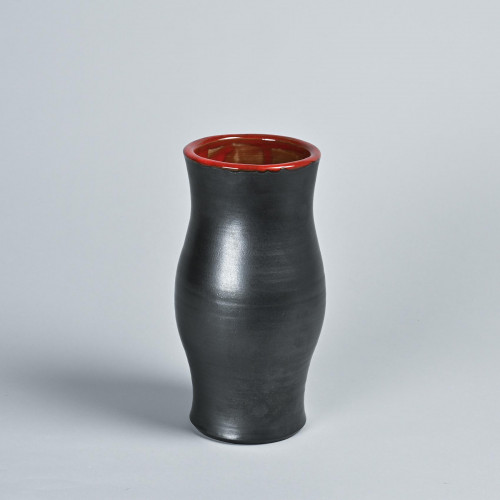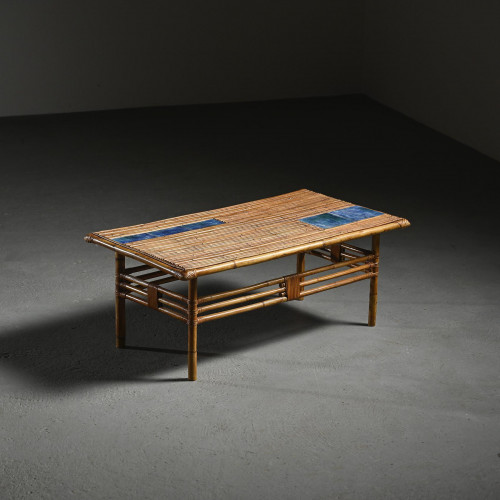Robert et Jean Cloutier (1930 - 2008)
To dive into the world of Robert and Jean Cloutier, the twin brothers of French ceramics, is to immerse in an abundant and dreamlike universe.
Robert and Jean were born in Paris in 1930. French ceramicists and sculptors, they led a long joint career until Robert's death in 2008.
They were trained in the rudiments of ceramics and stucco at the Meaux School of Ceramics, they continued to develop their skills throughout their career working in various Parisian workshops. They both worked at Lafourcade until Robert joined the studio of Georges Jouve and Jean that of Michel Rivière. Pol Chambost, a notorious sculptor and ceramist, then hired them.
In 1955, they opened their own ceramic workshop in Paris, in which they create utilitarian ceramics such as tableware, pots, vases, lamps or trays with strong decorative potential. The pieces are decorated with anthropomorphic figures : human busts, couples, children or zoomorphic figures such as bulls, hens, owls, roosters or ibex. They invent hybrid characters, a mermaid or a half-bird man that are reminiscent of mythology. The theme of music is also frequently represented through the lyre. While the influence of Georges Jouve and Marie Vassilieff is strong, the Cloutier Brothers develop their own style, a very personal poetry, or dreamworld. They experiment with different materials: ceramics, glazed earthenware, porcelain, terracotta, stoneware and plaster. They use intense colors in mono or bichromatic designs. It is during this period that they develop the "Cloutier Rouge" (Red), a red enamel that meets international success and contributes
To dive into the world of Robert and Jean Cloutier, the twin brothers of French ceramics, is to immerse in an abundant and dreamlike universe.
Robert and Jean were born in Paris in 1930. French ceramicists and sculptors, they led a long joint career until Robert's death in 2008.
They were trained in the rudiments of ceramics and stucco at the Meaux School of Ceramics, they continued to develop their skills throughout their career working in various Parisian workshops. They both worked at Lafourcade until Robert joined the studio of Georges Jouve and Jean that of Michel Rivière. Pol Chambost, a notorious sculptor and ceramist, then hired them.
In 1955, they opened their own ceramic workshop in Paris, in which they create utilitarian ceramics such as tableware, pots, vases, lamps or trays with strong decorative potential. The pieces are decorated with anthropomorphic figures : human busts, couples, children or zoomorphic figures such as bulls, hens, owls, roosters or ibex. They invent hybrid characters, a mermaid or a half-bird man that are reminiscent of mythology. The theme of music is also frequently represented through the lyre. While the influence of Georges Jouve and Marie Vassilieff is strong, the Cloutier Brothers develop their own style, a very personal poetry, or dreamworld. They experiment with different materials: ceramics, glazed earthenware, porcelain, terracotta, stoneware and plaster. They use intense colors in mono or bichromatic designs. It is during this period that they develop the "Cloutier Rouge" (Red), a red enamel that meets international success and contributes
greatly to their notoriety. In 1960, they also develop new cooking techniques.
In 1956, they exhibit at the Salon des Artistes Décorateurs and short after at the Salon des métiers d'art and at the Salon des Ateliers d'Art de France. Parisian galleries such as La Demeure or Alain Gutharc showcase their creations. During the same decade, they collaborated with a few firms and signed exclusive models for Haviland, a manufacture specializing in luxury tableware based in Limoges. Mitsukoshi, a large Japanese chain of stores, also places several orders with the brothers and invites them to Tokyo in 1970. They thus participate in the revival of ceramics in the second half of the twentieth century.
The Cloutier brothers devote themselves to some interior architecture projects by bringing their touch through wall decorations, tables, enameled tiles, claustra walls - very aesthetic partitions with a system of openings that let light through. Their designs are sought by some of the most notable brand in France, Galeries Lafayette, Air France or the Maison de l'Iran on the Champs-Élysées.
In 1972, Robert and Jean moved to the Yonne before settling permanently in Marsillargues, in the South of France, in 1978. They sell their creations of the time, more decorative than ever, in a shop located in Lunel.
Robert passes away in 2008 and Jean in 2015. Two tribute exhibitions were organized in their honour, one at Galerie Z (Aigues-Mortes) in 2015 and the other at Galerie Thierry Carretero (Nîmes) in 2016.
© Formes Utiles, Nov. 2020





















